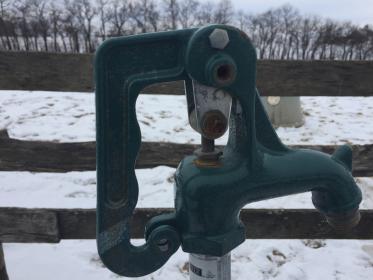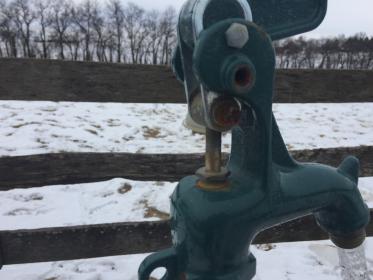There are not a lot of moving parts, not a lot of “parts” in general to a hydrant. The handle “hinge” should be oiled/greased periodically. As should the rod that is attached to the hand when the hydrant has been opened. This rod passes through a rubber “O ring” seal. Which keep seals around the rod keeping water from coming out. The O ring seal can and does dry out over time it is a “wear part” that is replaceable. A small amount of water can get between the rod and seal when opened. When closed it can and does freeze to the rod which can and does make it hard to open. I use petroleum jelly or grease and coat the rod when it is opened. And then open and close it to work the lubricant into the joint. Do not use silicone spray this can and does breakdown rubber.
If the above doesn’t solve the problem there’s really only one other reason that I can think of. You don’t give you location which really help with just about all questions on the forum. But especially in this forum. Geographic location, weather has a lot to do with things and possible answers, suggestions.
I assume you are have having colder than normal temps like a lot of the country? When the hydrant is turned off the water left in the riser pipe has to drain out of the bottom just above the bottom “valve” that the rod is attached to. If it is slow draining and the hydrant was not buried deep enough good chance due to very cold temps there is some water left at the bottom that is freezing before all of it drains out.
Question; After you get it open and the water runs normally. Does the handle open and close normally? If so most likely you have a slow draining situation and there is some water freezing at the bottom. Good chance this will only get worse depending on temps and how long they stay subfreezing.
I don’t think wrapping he exposed pipe with heat tape will do much. It doesn’t get that hot. If water is freezing at the bottom due to slow draining. I doubt heat tape will heat the pipe enough below grade to melt this. A good torch held just above the grade (dirt) may, should heat the pipe all the way down to the bottom. It didn’t on a hydrant I had a freeze issue with. Might be worth a try.
You can buy some non poisonous antifreeze put it in a squeeze bottle with some tubing on the end so you can squirt a couple of ounces of it into the hydrant after each use until your temp return to normal. Just flush it out before filling buckets, tubs, etc.
There is a product that diary farmers use on their frozen hydrants. Can’t think of the name. Do a search or someone or someone around here may know what I am talking about.
I would start with lubing the handle and rod first and hope that fixes the problem.
OP, Everyone that starts a discussion. Please TAG your thread so others can find it when doing a search. LOTS of common farm/horse problems, issues come up all the time. And are repeatedly addressed.


